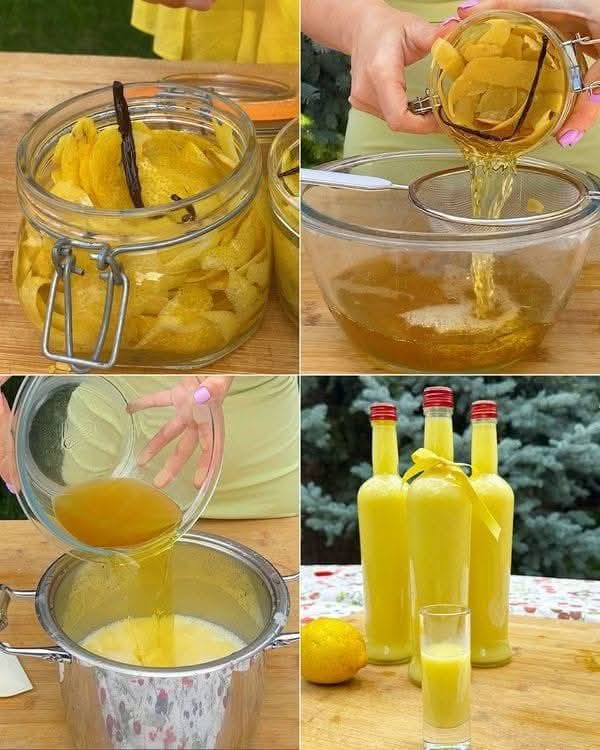Introduction
Limoncello is a traditional Italian liqueur known for its bright and refreshing lemon flavor. It is typically enjoyed as a digestif after meals.
offering a burst of citrusy sweetness with a smooth, slightly alcoholic finish. Making limoncello at home.
allows you to capture the essence of Italy’s Mediterranean landscape in every sip. The recipe is relatively.
simple but requires patience as the flavors meld over time, creating a deliciously aromatic drink.
Ingredients
-5–6 lemons (preferably organic)
-500 ml (2 cups) of water
-500 ml (2 cups) of high-proof alcohol (like vodka or grain alcohol)
-300–350 grams (1.5 cups) of sugar
Instructions
Begin by thoroughly washing the lemons. Since you’ll be using the zest, it’s important to remove any wax or chemicals that may be on the skin.
Using a vegetable peeler, carefully peel the lemons, making sure to avoid the bitter white pith beneath the skin. Set the lemon zest aside.
Next, place the lemon peels into a large glass jar or container that can be sealed tightly. Pour the high-proof alcohol over the lemon zest, ensuring the peels are fully submerged.
Seal the jar and store it in a cool, dark place for about 7–10 days. During this time, the alcohol will extract the essential oils from the lemon peels, infusing the liquid with bright, citrusy flavors.
After the infusion period, it’s time to make the simple syrup. In a saucepan, combine the water and sugar.
stirring gently over medium heat until the sugar is fully dissolved. Once the sugar has dissolved, remove the syrup from the heat and let it cool completely.
Once both the infused alcohol and the simple syrup are cool, strain the lemon peels out of the alcohol using a fine mesh strainer or cheesecloth.
Add the cooled syrup to the infused alcohol and stir well. Taste the mixture, and if you prefer a sweeter limoncello, you can add more sugar syrup to adjust the sweetness.
Pour the completed limoncello into bottles or jars for storage. Seal them tightly and let the liqueur rest.
for at least 24–48 hours to allow the flavors to meld. For a smoother taste, you can also let it age in a cool, dark place for a few weeks.
Once the limoncello has matured, it’s ready to be enjoyed! Serve it chilled in small glasses, either as a shot or over ice. The refreshing, zesty citrus flavor will bring a delightful burst to your palate.
How to Make
Making limoncello at home is both simple and rewarding. First, make sure you have the best ingredients you can find, starting with organic lemons to ensure that the zest is free from pesticides.
The high-proof alcohol serves as the base for extracting the vibrant flavors, so choose one with a neutral taste to let the lemon shine.
The sugar syrup is the key to balancing the tartness of the lemons, so feel free to adjust it to suit your personal preference for sweetness.
When zesting the lemons, be cautious not to peel too deeply, as the bitter white pith can spoil the flavor of the liqueur.
After the infusion period, the lemony fragrance should fill your jar, and the alcohol will have taken on a beautiful yellow hue.
Straining out the zest before mixing with the syrup is important to avoid any bitterness in the final product.
The syrup should be cooled completely before adding it to the alcohol; otherwise, the heat can alter the balance of flavors.
Once the limoncello is mixed, allow it to rest so the flavors can fully combine, giving it time to develop the smooth.
aromatic quality it is known for. The key to great limoncello is patience, as the longer it sits, the better the flavor will become.
Tips
Start with high-quality lemons, preferably organic, to avoid any unwanted chemicals or wax coating on the peel.
A vegetable peeler is the best tool for zesting the lemons, as it removes the zest without cutting into the bitter white pith.
Be sure to allow the mixture to infuse for the full 7–10 days to ensure the alcohol absorbs the full flavor of the lemon peel.
While you may be tempted to rush the process, a longer infusion period yields a more flavorful limoncello.
For a smoother finish, let your limoncello rest for several weeks before drinking. During this time, the flavors will mature, and the drink will become even more refined.
If you prefer a stronger drink, you can adjust the alcohol-to-syrup ratio based on your taste.
Straining the lemon peels carefully is crucial to ensure that no bitterness is transferred into the liqueur. You may want to double strain using a cheesecloth for an extra smooth finish.
Experiment with different types of alcohol. While vodka is a common choice, grain alcohol, which has a higher proof, will give a stronger base for a more intense flavor.
If you prefer a slightly less sweet version of limoncello, reduce the amount of sugar in the syrup. Alternatively, if you want a more pronounced sweetness, increase the sugar content.
Store the limoncello in glass bottles or jars and keep it in a cool, dark place to allow the flavors to meld.
The longer it sits, the better it will taste, but it can be consumed right after the infusion period if you prefer a quicker result.
Conclusion
Homemade limoncello is a wonderfully versatile and refreshing drink that captures the essence of sun-soaked Italian summers.
Whether you serve it as a digestif, enjoy it in cocktails, or simply sip it on its own, it adds a delightful touch of citrus to any occasion.
With a bit of patience and the right ingredients, you can create your own limoncello at home, ensuring that every sip is full of fresh.
authentic flavor. By following these simple steps, you’ll soon be savoring your homemade creation and sharing it with friends and family.
